Creative Ways to Foster International Awareness
A MiddleWeb Blog
I’ve been teaching internationally since 2003, and it has impacted every aspect of my life. I love sharing my experiences with my students in the hopes that they will become more globally minded and curious people. I’d like to share a few ways that I use my classroom to open the world up to my middle graders.
Incorporate Geography into All Classes
Use your maps. Schools are often full of maps that can be filler on bulletin boards. Try to get one in every classroom and mark them up as much as you can. In English class students can add a pin to the location of a book they’re reading or where an author is from. Social studies students can mark the locations they are studying, just as science students can pinpoint where discoveries were made.
Maps are a visual provocation for important questions: what areas are missing from our reading lives? Why were there so many scientific advances in certain areas of the world? Where does our curriculum focus its attention?
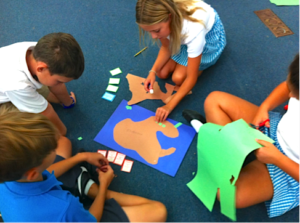
Playing Galactic Mappers from Institute of Play
Make geography fun. The Institute of Play game Galactic Mappers tasks students with collaborating to create landforms on an alien planet, cementing their understanding of physical geography. Give students a chance to play Geoguessr, a game where they get a 360-degree view of a location, then must guess where in the world it is. The closer they are to the location, the more points they get. This can help students better visualize places (France isn’t just the Eiffel Tower) and become more familiar with foreign landscapes and languages.
Another interesting site is thetruesize.com, which allows you to compare the size of a country as it appears on a map with how large it actually is when dragged over other countries. I remember being fascinated when I first learned about the Mercator projection in middle school. Sites like this pique students’ curiosity about what the world really looks like.
Connect with the World
Let others help you connect. At the beginning of the year, send out an email to parents and other friends letting them know the topics you’ll be studying this year, asking if anyone has any related contacts who would like to speak with your class.
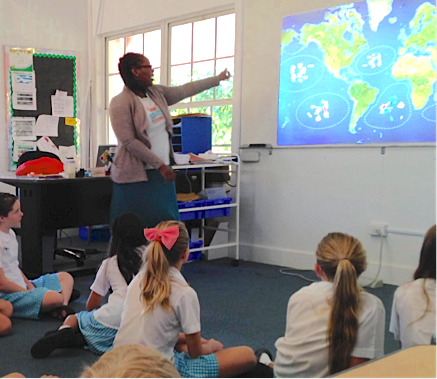
Guest speaker Kristal Ambrose of the Bahamas Plastic Movement taught us about the Great Pacific Gyre. We spoke with scientists studying Tamu Massif, the world’s largest single volcano.
Small actions like this led to my class having amazing conversations with NASA scientists about Mars rovers, speaking with researchers who were at sea studying the world’s largest single volcano, and getting to hold a bottle of polluted water from the Great Pacific Gyre.
Before each conversation, mark the class map with the location. The more contact students have with professionals, the more realistic these careers become for them.
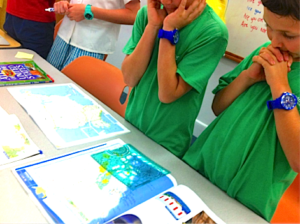
A tense moment during a Mystery Skype
Take advantage of organizations that will find the contacts for you. Virginia Institute of Marine Science’s Scuttlebutt list often has opportunities for calls with marine scientists, Skype in the Classroom offers virtual field trips and guest speakers, and Exploring By The Seat Of Your Pants hosts Google Hangouts with scientists and conservationists.
Participate in a worldwide event. Every October the Global Read Aloud selects a book that is read by students around the world with as many global connections as possible. The Hour of Code is an hour-long introduction to computer science that has participants in over 180 countries.
Classrooms can plan to collaborate throughout Computer Science Week every December. A new event is the Global School Play Day, which focuses on unstructured play for students of all ages. One of the goals of GSPD is no devices, but you can still discuss with other classes in advance and share photos and blog posts after the event.
Make your Classroom a Place to Celebrate Internationalism
Incorporate current events into your class. Sarah Cooper wrote a helpful article on MiddleWeb on how to do so. We want our students to be informed and inquisitive, and studying current events fosters both of those traits. In my class, we like to watch Flocabulary’s Week in Rap, which is a two minute video that shares some highlights from around the world.
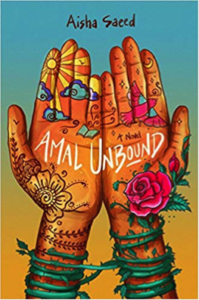
My class participated in the Books Without Borders Challenge and loved sharing new international titles with each other. All teachers can add informative nonfiction books to their classrooms; the WorldGeoChat blog has a list of excellent suggestions.
Appreciating the world beyond the classroom
There are so many benefits to having internationally minded students. Learning about the world makes them more curious and appreciative of different cultures. They will find it easier to make connections in their classes and understand how politics, geography, and culture influence current events. The empathy they gain will extend beyond the classroom as they become respectful global citizens.
Photos: Megan Kelly

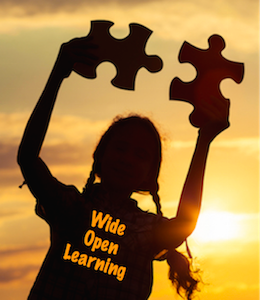

































This is a fantastic article! I always enjoy your blogs. Thank you for sharing!
I do miss having a map in my classroom when I am teaching music classes!
Great ideas!
This blog is full of great information. I am currently in school to become a middle school social studies teacher. During my education I’ve had multiple professors stress the importance of implementing curriculum where all students feel as though they see themselves. I think this blog is full of great insights as to how I can implement lessons that show my students that there is so much more out there to learn about and discover that exists outside the United States. I think the resources you mentioned will aid in my students’ development of cultural pluralism.
I like your suggestion to encourage students to be informed and inquisitive. I think it’s incredibly important to know what is happening in our world. It’s good to know that there are people out there who are able to convey what’s happening in the world in terms that everyone can understand.